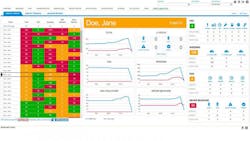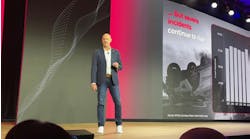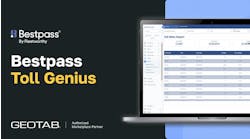You often hear fleet management and telematics systems companies say they've integrated a third-party application and it will work with their platform. Now get ready for the next level: software and systems unification.
What's that? Think of this unification as making different systems and applications work in combinative, complementary ways rather than just being able to run with or on a given platform — i.e., working together, not just tolerating each other.
Trucking got a notable dose of next-level technology systems integration, for instance, when Bendix showed last summer how its Wingman Fusion product has radar and video systems that help instruct each other. The systems detect potential obstructions or objects in a truck's path in different ways, but together they can make better determinations on things like whether an object ahead is a soda bottle or a stopped car.
In another new take, fleet management technology company PeopleNet has decided to roll up telematics information from trucks — associating it with particular drivers — into its video product interface and in customizing what triggers video clips to be sent to fleet managers.
"We can trigger video [being sent to the back office] off of what the truck and driver actually do, not an accelerometer. Those are a good start, but accelerometers can trigger all the time and it's not meaningful," notes Jim Angel, vice president for video intelligence solutions at PeopleNet. "We've had this deep integration to ECM [electronic control module] data coming off the J1939 [bus] for over a decade. Why not use it?
"We can trigger videos based on what the customer says — 9 mph per sec. deceleration, 7 mph per sec. acceleration, whatever — and give the carrier the flexibility to manage to the level they want to," he continues. "When that deceleration triggers from the ECM, that's where we get our trigger — not when I hit a pothole in the middle of the road that sets off an accelerometer."
That can fine-tune video clips that are sent to fleet managers for review, but there's more you can do once you start combining telematics and video. Angel points to a dash cam video showing two passenger cars cutting in front of a truck, the second one very nearly causing a crash; had the truck driver not hit the brakes quickly, there would've been a collision.
"If you didn't have the video with something like that, the argument would've started," Angel says. "In this case, the driver did a great job, so now we can send 'safe driving' recognition where we're going to give him a credit on his safety analytics score. This all ties back to our safety analytics and what we've built as part of the PeopleNet system," he explains, discussing the telematics-enhanced video product's inclusion of color-coded, filterable driver scorecard info.
"You also have the opportunity to review risky or problem behaviors," Angel adds. "We can bring a whole bunch of data into one place and make it easy to use."
More in store
Expect more collaborative, complementary systems integrations — or unifications — going forward from the world of truck telematics. Omnitracs recently said as much, discussing the second wave of a major product launch and refresh program it's been progressing through.
Back in early 2015, the company announced its OTIS project, for Omnitracs Integrated Telematics Solution. The first phase of OTIS comes this year, as Omnitracs rolls out a new, more advanced in-cab telematics box called the Intelligent Vehicle Gateway, or IVG. The idea is to consolidate and focus the company's hardware platforms.
Beyond hardware, however, Omnitracs has also been building its applications portfolio substantially. And Dan Speicher, the company's chief technology officer, said earlier this year Omnitracs wants not only to bring those apps together, but to move toward being "hardware agnostic" and able to run on various devices a fleet or trucking company might use.
Laura Lohrke, Omnitracs' product manager for mobile, describes working toward those two concepts simultaneously. "We've had these separate solutions with these different companies that have come together under Omnitracs. We've got some really powerful products," she says. Meanwhile, by 2020, industry analysts predict there will be anywhere from 25 billion to 40 billion or more mobile devices of various kinds in the market globally, and Omnitracs is looking to those, too, as possible interfaces for its products.
"Playing off the idea of the Internet of Things, we're already tracking trucks; we're tracking people. Those are very important assets in this industry," Lohrke tells Fleet Owner. "We're looking to make things simpler for the drivers as well as back-end managers, where you have a single sign-on and all these functions talking to each other and working together in unison, and coming to a central back end.
"We've really been working on not just integration of our different offerings, but unification of them," she continues. "It's not just like a third party integration; we're looking to bring a unified solution with all those analytics tools.
"We've started that, and it's just going to continue throughout the year."




